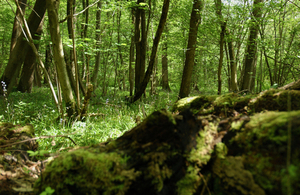Plant biosecurity strategy nears completion
The plant biosecurity strategy that will safeguard the future of the UK’s trees and plants from pests and disease nears completion

Woodland
Environment ministers brought together a wealth of experience and expertise today to help draft a new plant biosecurity strategy that will safeguard the future of the UK’s trees and plants against the threat of diseases like ash dieback.
The ‘Plant Health Stakeholder Summit’ held in London, will help develop a coordinated approach across the country for dealing with pests and diseases with representatives from government, woodland groups, academia and industry in attendance.
A key element has been the development of a risk register, published today, highlighting 700 possible threats to Britain’s trees and plants.
Environment Minister Lord de Mauley, said:
Safeguarding the future of our trees and plants is enormously important – on more than one occasion we have seen the dreadful trail of destruction such diseases can leave behind. And it’s not just the environment that suffers, but the economy too.
It is vital for us to work with those outside of government to get this plant health strategy right and successfully protect our environment from biosecurity threats. The register is an essential step forwards in helping us to identify all potential threats and plan against them.
Defra has also already created a new Chief Plant Health Officer post that will lead on the risk register and contingency planning.
Assistant Chief Plant Health Officer Richard McIntosh, said:
Getting a wide range of input at this stage of the plant biosecurity strategy is invaluable, it is very important that we get this strategy right for everyone working with trees and plants.
We will be looking at increasing our activity on surveillance and research over the next few years in order to ensure we protect our trees and plants as much as possible and are ready to deal with any threats to them.
The register will not only identify threats in a timely fashion, it will also help a range of groups, including nurseries and woodland managers, to consider and manage risk effectively.
The risk register was recommended in the Tree Health and Plant Biosecurity Taskforce Report published in May 2013. The Taskforce was set up by Environment Secretary Owen Paterson following the discovery of Chalara fraxinea (ash dieback) in the UK in 2012, to consider and address the current and possible future threats to tree health. It was made up of a group of expert scientists and chaired by Professor Chris Gilligan of Cambridge University.
This report made eight recommendations to improve plant and tree health in the UK - government has accepted all of these recommendations and the strategy will implement the outstanding actions.
Defra has made tree and plant health one of its top priorities and is continuing to tackle tree pests and diseases, including Chalara, by:
- introducing tighter controls on the import of oak, ash, plane and sweet chestnut trees
- allocating £8m for research into diseases that could affect our trees
- planting 250,000 ash saplings to monitor for genetic resistance to Chalara and commissioned research to investigate genetic resistance in a laboratory setting
- investigating 14 products as potential treatments for Chalara
The plant biosecurity strategy will now be developed drawing on the thoughts of the attendees of the summit and other stakeholder engagement and is due to be published later in the Spring.
To see the first phase of the risk register please visit the FERA website.